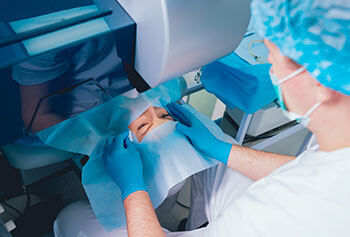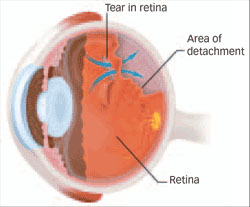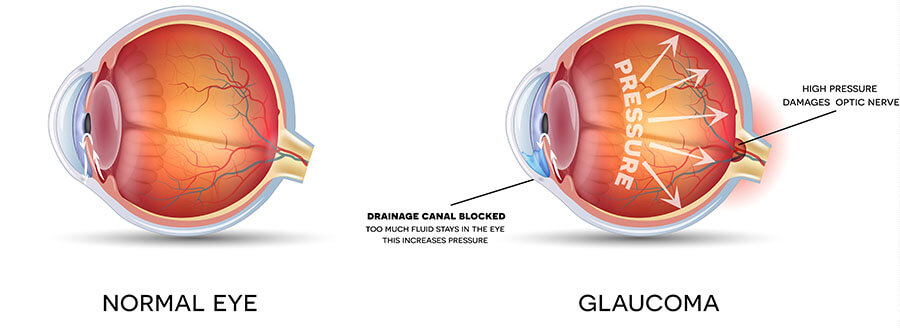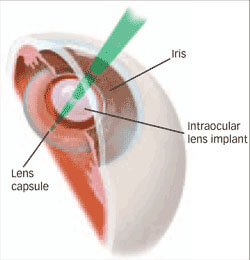
The word laser stands for “Light Amplification by Stimulated Emission of Radiation.” A laser is a concentrated beam of light, created when an electric current passes through a special material.
The name and the color of the laser depend on the type of special material that is used:
Laser surgery in ophthalmology can successfully treat many types of eye diseases. There are two different ways that lasers are used to treat eye diseases. Thermal lasers (argon and krypton): The light is converted to heat when it reaches the eye.
The heat is used to:
Photodisruptive lasers (YAG and excimer): The light cuts or sculpts the tissue, similar to a knife.
The beam of light is used to:
Laser surgery of the eye has several advantages:

Retinal tears or holes: The retina is the inner layer of the eye that senses light and helps you to see. If the retina tears, it can separate from the back wall of the eye. This is called a detached retina, and it can cause you to lose sight. Symptoms of retinal tears include:
Most retinal tears can be treated with the argon or krypton laser, if they are found before the retina detaches. The laser helps bond the retina to the wall of the eye, preventing a retinal detachment.
If retinal detachment has already occurred, the laser may be used as part of a surgical repair of the detachment.
Diabetic retinopathy: Eye disease from diabetes is a major cause of vision loss. Diabetes can cause blood vessels in the retina to grow abnormally. The vessels can leak fluid (macular edema) or bleed inside the eye.
Macular degeneration: The macula is the small, central area of the retina that allows us to see fine details clearly. Macular degeneration affects your central or reading vision.

Most people have “dry” macular degeneration, which cannot be helped by laser surgery.
A few people have “wet” macular degeneration. With this condition, abnormal blood vessels cause bleeding and scarring of the macula. In certain cases, these people may be treated with the argon or krypton laser. The laser seals the blood vessels to prevent further damage.
There are other retina problems that can be treated with the laser, including:
After a cataract has been removed, the capsule of the lens sometimes becomes cloudy. The neodymium-YAG laser can open up this cloudy membrane and restore clear vision.
Glaucoma is a disease of the optic nerve. This nerve sends images from the eye to our brain and allows us to see. Glaucoma is the second most common cause of blindness in the United States, and the leading cause of legal blindness among African Americans.

Glaucoma damages the optic nerve, usually because the fluid pressure inside the eye is too high. Loss of vision from glaucoma can often be prevented if your ophthalmologist discovers the disease before much damage occurs to the optic nerve.
Glaucoma must be detected early if treatment is to be successful.
Eyedrops or pills are the usual way to treat glaucoma. If they do not control the pressure within the eye, laser surgery may be used to lower the pressure.

In procedures such as photorefractive keratectomy (PRK), and laser in situ keratomileusis (LASIK), the excimer laser is used to sculpt the cornea and reduce or eliminate the need for eyeglasses or contact lenses.
Laser surgery has been one of the great advances in treating eye diseases. The success of the laser depends on the type of eye disorder.
In most situations, laser surgery helps prevent further loss of sight, but will not provide great improvement in vision. In a few situations, such as YAG laser surgery, PRK or LASIK, vision may be improved considerably.
Your ophthalmologist (Eye MD) will discuss the risks and benefits that laser treatment can offer you.
You’ll see that when it’s time to make an appointment with a specialist in Retina and Vitreous diseases, you can trust your eye health to the team at Inland Valley Retina Medical Associates, Inc.